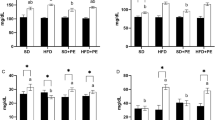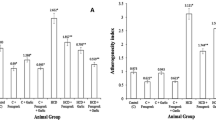Abstract
Conglutin γ and phytate are considered as potential biofunctional compounds of lupin protein isolate, but their impact on vascular health is unknown. This study aimed to investigate the effect of conglutin γ and phytate, respectively, on circulating levels of sterols, markers of cholesterol biosynthesis and minerals, and on the development and progression of aortic lesions in apoE-deficient mice. To this end, mice were fed a western diet with either casein (200 g/kg; served as a control), conglutin γ from L. angustifolius (200 g/kg) or casein (200 g/kg) supplemented with phytate (5 g/kg) for 16 weeks. Here we found that conglutin γ but not phytate was capable of reducing the circulating concentration of cholesterol. Plasma levels of desmosterol and lathosterol as markers of the cholesterol synthesis were not affected, and 7-dehydrocholesterol was even higher in mice fed conglutin γ than in mice fed casein or casein + phytate. All mice developed pronounced aortic lesions, but histological characterization of plaque area and composition showed no differences between the three groups of mice. Conclusively, conglutin γ exerts cholesterol-lowering effects but appears to have no anti-atherosclerotic properties in the apoE-deficient mice. Phytate neither affected plasma cholesterol nor aortic lesion development.

Similar content being viewed by others
Abbreviations
- DM:
-
Dry matter
- ICP OES:
-
Inductively coupled plasma optical emission spectroscopy
- L :
-
Lupinus
- 25(OH)D3 :
-
25-hydroxyvitamin D3
- 7-DHC:
-
7-dehydrocholesterol
References
Cerletti P, Duranti M, Restan P (1983) Properties of lupine proteins relevant to their nutritional performance. Plant Foods Hum Nutr 32:145–154
Bettzieche A, Brandsch C, Weisse K, Hirche F, Eder K, Stangl GI (2008) Lupin protein influences the expression of hepatic genes involved in the fatty acid synthesis and triacylglycerol hydrolysis of adult rats. Br J Nutr 99:952–962
Brandsch C, Kappis D, Weisse K, Stangl GI (2010) Effects of untreated and thermally treated lupin protein on plasma and liver lipids of rats fed a hypercholesterolemic high fat or high carbohydrate diet. Plant Foods Hum Nutr 65:410–446. doi:10.1007/s11130-010-0201-5
Fontanari GG, Batistuti JP, da Cruz RJ, Saldiva PHN, Arêas JAG (2012) Cholesterol-lowering effect of whole lupin (Lupinus albus) seed and its protein isolate. Food Chem 132:1521–1526
Weisse K, Brandsch C, Zernsdorf B, Nkengfack Nembongwe GS, Hofmann K, Eder K, Stangl GI (2010) Lupin protein compared to casein lowers the LDL cholesterol:HDL cholesterol-ratio of hypercholesterolemic adults. Eur J Nutr 49:65–71
Bähr M, Fechner A, Krämer J, Kiehntopf M, Jahreis G (2013) Lupin protein positively affects plasma LDL cholesterol and LDL:HDL cholesterol ratio in hypercholesterolemic adults after four weeks of supplementation: a randomized, controlled crossover study. Nutr J 12:107. doi:10.1186/1475-2891-12-107
Marchesi M, Parolini C, Diani E, Rigamonti E, Cornelli L, Arnoldi A, Sirtori CR, Chiesa G (2008) Hypolipidaemic and anti-atherosclerotic effects of lupin proteins in a rabbit model. Br J Nutr 100:707–710
Weisse K, Brandsch C, Hirche F, Eder K, Stangl GI (2010) Lupin protein isolate and cysteine-supplemented casein reduce calcification of atherosclerotic lesions in apoE-deficient mice. Br J Nutr 103:180–188
Sirtori CR, Lovati MR, Manzoni C, Castiglioni S, Duranti M, Magni C, Morandi S, D’Agostina A, Arnoldi A (2004) Proteins of white lupin seed, a naturally isoflavone-poor legume, reduce cholesterolemia in rats and increase LDL receptor activity in HepG2 cells. J Nutr 134:18–23
Schlemmer U, Frølich W, Prieto RM, Grases F (2009) Phytate in foods and significance for humans: food sources, intake, processing, bioavailability, protective role and analysis. Mol Nutr Food Res 53:S330–S375
Rimbach G, Pallauf J, Brandt K, Most E (1995) Effect of phytic acid and microbial phytase on Cd accumulation, Zn status, and apparent absorption of Ca, P, Mg, Fe, Zn, Cu, and Mn in growing rats. Ann Nutr Metab 39:361–370
Pallauf J, Rimbach G (1997) Nutritional significance of phytic acid and phytase. Arch Tierernahr 50:301–319
Onomi S, Okazaki Y, Katayama T (2004) Effect of dietary level of phytic acid on hepatic and serum lipid status in rats fed a high-sucrose diet. Biosci Biotechnol Biochem 68:1379–1381
Lee SH, Park HJ, Cho SY, Jung HJ, Cho SM, Cho YS, Lillehoj HS (2005) Effects of dietary phytic acid on serum and hepatic lipid levels in diabetic KK mice. Nutr Res 25:869–876
Radtke J, Geissler S, Schutkowski A, Brandsch C, Kluge H, Duranti MM, Keller S, Jahreis G, Hirche F, Stangl GI (2014) Lupin protein isolate versus casein modifies cholesterol excretion and mRNA expression of intestinal sterol transporters in a pig model. Nutr Metab 11:9. doi:10.1186/1743-7075-11-9
Grases F, Prieto RM, Sanchis P, Saus C, De Francisco T (2008) Role of phytate and osteopontin in the mechanism of soft tissue calcification. J Nephrol 21:768–775
Grases F, Sanchis P, Perello J, Isern B, Prieto RM, Fernández-Palomeque C, Torres JJ (2007) Effect of crystallization inhibitors on vascular calcifications induced by vitamin D – a pilot study in Sprague–Dawley rats. Circ J 71:1152–1156
Zaragoza C, Gomez-Guerrero C, Martin-Ventura JL, Blanco-Colio L, Lavin B, Mallavia B, Tarin C, Mas S, Ortiz A, Egido J (2011) Animal models of cardiovascular diseases. J Biomed Biotechnol 2011:497841. doi:10.1155/2011/497841
Pendse AA, Arbones-Mainar JM, Johnson LA, Altenburg MK, Maeda N (2009) Apolipoprotein E knock-out and knock-in mice: atherosclerosis, metabolic syndrome, and beyond. J Lipid Res 50(Suppl):S178–S182. doi:10.1194/jlr. R800070-JLR200
D-Agostina A, Antonioni C, Resta D, Arnoldi A, Bez J, Knauf U, Wäsche A (2006) Optimization of a pilot-scale process for producing lupin protein isolates with valuable technological properties and minimum thermal damage. J Agric Food Chem 54:92–98
Bassler R (1976) Die chemische Untersuchung von Futtermitteln, 3rd edn. vol. 3. Methodenbuch. VDLUFA-Verlag, Darmstadt
Eder K, Peganova S, Kluge H (2001) Studies on the tryptophan requirement of piglets. Arch Tierernahr 55:281–297
Fontaine J, Bech-Andersen S, Bütikofer U, Froidmont-Göritz I (1998) Determination of tryptophan in feed by HPLC – development of an optimal hydrolysis and extraction procedure by the EU commission DG XII in three international collaborative studies. Agribiol Res 51:97–108
Harland BF, Oberleas D (1986) Anion exchange method for determination of phytate in foods: collaborative study. J Assoc Off Anal Chem 69:667–670
National Research Council (NRC), Committee on Animal Nutrition (1995) Nutrient requirements of laboratory animals. National Academy Press, Washington
Honda A, Yamashita K, Hara T, Ikegami T, Miyazaki T, Shirai M, Xu G, Numazawa M, Matsuzaki Y (2009) Highly sensitive quantification of key regulatory oxysterols in biological samples by LC-ESI-MS/MS. J Lipid Res 50:350–357
Mattila PH, Piironen VI, Uusi-Rauva EJ, Koivistoinen PE (1995) Contents of cholecalciferol, ergocalciferol, and their 25-hydroxylated metabolites in milk products and raw meat and liver as determined by HPLC. J Agric Food Chem 43:2394–2399
Huynh NN, Chin-Dusting J (2006) Amino acids, arginase and nitric oxide in vascular health. Clin Exp Pharmacol Physiol 33:1–8
Hirche F, Schröder A, Knoth B, Stangl GI, Eder K (2006) Effect of dietary methionine on plasma and liver cholesterol concentrations in rats and expression of hepatic genes involved in cholesterol metabolism. Br J Nutr 95:879–888
Foley RC, Gao LL, Spriggs A, Soo LY, Goggin DE, Smith PM, Atkins CA, Singh KB (2011) Identification and characterisation of seed storage protein transcripts from Lupinus angustifolius. BMC Plant Biol 11:59. doi:10.1186/1471-2229-11-59
Lovati MR, Manzoni C, Castiglioni S, Parolari A, Magni C, Duranti M (2012) Lupin seed γ-conglutin lowers blood glucose in hyperglycaemic rats and increases glucose consumption of HepG2 cells. Br J Nutr 107:67–73. doi:10.1017/S0007114511002601
Mardiewicz LH, Honke J, Haros M, Swiatecka D, Wróblewska B (2013) Diet shapes the ability of human intestinal microbiota to degrade phytate – in vitro studies. J Appl Microbiol 115:247–259. doi:10.1111/jam.12204
Miettinen TA, Gylling H, Nissinen MJ (2011) The role of serum non-cholesterol sterols as surrogate markers of absolute cholesterol synthesis and absorption. Nutr Metab Cardiovasc Dis 21:765–769. doi:10.1016/j.numecd.2011.05.005
Xu L, Korade Z, Porter NA (2010) Oxysterols from free radical chain oxidation of 7-dehydrocholesterol: product and mechanistic studies. J Am Chem Soc 132:2222–2232. doi:10.1021/ja9080265
Acknowledgments
This study was supported by a grant from the Federal Ministry of Education and Research of Germany (01EA1338B).
Conflict of Interest
The authors declare that they have no conflict of interest.
Author information
Authors and Affiliations
Corresponding author
Rights and permissions
About this article
Cite this article
Radtke, J., Schutkowski, A., Brandsch, C. et al. Isolated Conglutin γ from Lupin, but not Phytate, Lowers Serum Cholesterol Without Influencing Vascular Lesion Development in the ApoE-deficient Mouse Model. Plant Foods Hum Nutr 70, 113–118 (2015). https://doi.org/10.1007/s11130-015-0481-x
Published:
Issue Date:
DOI: https://doi.org/10.1007/s11130-015-0481-x




